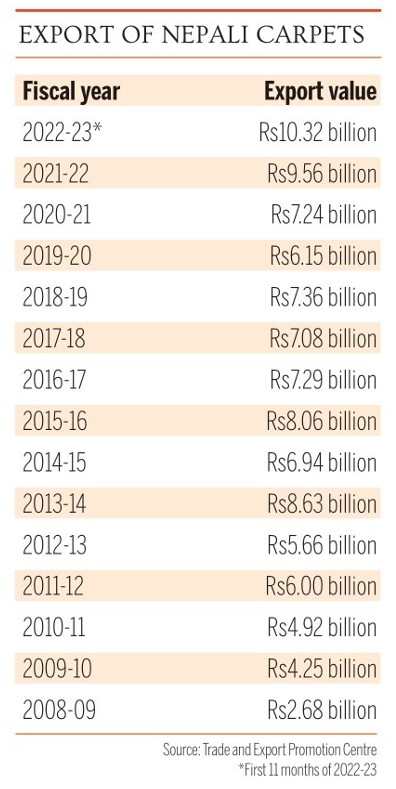Money
Nepali carpet exports make strongest rebound ever
Shipments in the first 11 months of the fiscal year amounted to an all-time high of Rs10.32 billion.
Krishana Prasain
Nepal’s carpet exports in the first 11 months of the fiscal year amounted to an all-time high of Rs10.32 billion, which insiders say, is a sign that the iconic carpet industry is making a strong rebound. Hand-woven woollen carpets were once the country's largest foreign currency earner.
The cumulative effect of inflationary pressure and costlier raw materials has increased the value of Nepali carpet exports, but considering the jump in volume, it can be said that the carpet industry is definitely making a big comeback, according to exporters and manufacturers.
Nepali traders say that supply chain disruptions in the last three years due to the Covid pandemic led to a rise in demand for Nepali carpets in overseas markets.
According to the statistics of the Trade and Export Promotion Centre, shipments were up 20 percent year-on-year in terms of value in the review period ended mid-June 2023.
In terms of volume, exports amounted to 444,365 square metres, up 11.25 percent year-on-year.
Ram Bahadur Gurung, president of the Nepal Carpet Manufacturer and Exporter Association, says it’s a good sign showing that the carpet sector is reviving. “If the government supports the sector, we can export carpets worth Rs30 billion annually within a few years. It can balance Nepal’s trade position.”
Carpets were once one of the country's leading exports. In the 1990s, the industry boomed and became a major source of foreign currency.
According to a report published by the International Labour Organisation, Nepal’s carpet industry provided 250,000 to 300,000 jobs during its “Gold Rush” period in the early 1990s.
Carpets accounted for 65 percent of the country's total exports. The Gold Rush period opened up new opportunities for the poorest of the poor on a massive scale, according to the report.
The carpet industry was one of the most prominent sectors with a remittance economy that benefited rural communities, alluring large numbers of people from remote districts to Kathmandu.
Nepal’s carpet sector experienced its first export boom in 1976, according to the International Labour Organisation. The industry then went through alternate spells of boom and bust.
The bubble burst when reports emerged that the carpet factories were exploiting child workers.
The Great Recession or the economic downturn from 2007 to 2009 after the United States housing bubble and the global financial crisis led to the downfall of the Nepali carpet industry.
Subsequent political instability in Nepal detracted new investments and threatened the operation of carpet factories. Nepali traders say the industry could make a comeback if the government’s policy becomes favourable.
Carpets accounted for 7.2 percent of Nepal's total exports in the first 11 months of this fiscal year.
According to Gurung, the export price of carpets is currently more than $175 per square metre compared to $165 per square metre a few years ago.
“With the latest designs, demand for Nepali carpets is growing. Orders from international buyers are rising, especially from the big players in the US and European markets,” Gurung said.
“We are mainly using Chinese silk to make our carpets. It costs Rs4,000 per kg, which makes carpets expensive. We have also been using high-quality hemp, allo and nettle to make carpets.”
Earlier, Nepali carpet producers were using cheap wool to weave carpets which used to cost Rs400 per kg, they said.
Manufacturers say that the government needs to build infrastructure for the export of carpets and provide loans at minimum interest rates.
Nepali carpet exporters receive 5 percent cash incentive and the product is also listed under the Nepal Trade Integrated Strategy 2016.
As per the association, there are nearly 800 carpet factories operating across the country, employing 200,000 persons. More than one-third of carpet production is done outside Kathmandu Valley.
“In recent years, the quality of raw materials was one of the major factors behind the rise in demand. Carpet manufacturers import woollen yarn from New Zealand and China. Hemp, nettle and allo come from Dolpa, Rolpa and other districts,” said Gurung.
“There is another global economic slowdown now. Even then demand for Nepali carpets is rising which is a clear indication that the carpet industry's future looks bright,” said Bhim Bahadur Tamang, proprietor of Bhume Gumba Carpet Udhyog in Mulpani which is one of the key exporters.
Tamang, who has been involved in the carpet sector for the last two and a half decades, said the rise in Nepali carpet demand lately is because of the quality.
“We export high quality materials like Chinese silk and pashmina. The price of raw materials is obviously high, but the quality is assured.”
He said that it used to cost Rs100,000 to make a carpet from ordinary wool in the past. "But using high quality materials, it now costs Rs500,000 to Rs1 million to make a carpet," Tamang said.
“Besides, Nepali carpet workers today have better capacity and improved skills. They can knit any design of any type as per the order from the global players.”





 9.12°C Kathmandu
9.12°C Kathmandu














